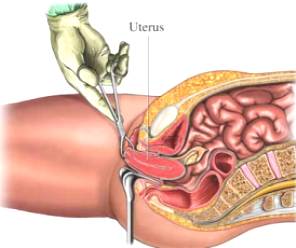Traditionally, the effective treatment for fibroid tumors is removing the entire uterus in a surgical procedure called as hysterectomy (hysterectomy procedure).
Most of the physicians continue to suggest hysterectomy as a standard technique for treating uterine fibroid tumors.
But, there are some potential drawbacks associated with hysterectomy. They include:
- General anesthesia that is given at the time of the surgery has various side effects and can cause various health problems.
- There is a two percent risk of post operative bleeding, 15-38% risk of postoperative fever and 0.5% risk of injury to the nearby pelvic region.

- The occurrence of heart disease (heart disease in women) raises three fold in a premenopausal woman who is undergoing hysterectomy procedure.
- 15-30% of women who had undergone hysterectomy reported that there is decreased sexual function after the treatment and there is increased incidence of depression after the surgery.
Hysterectomy is the only procedure that helps to remove the uterine fibroids completely. Permanent removal of uterus is necessary because most of the fibroid tumors are attached to the uterus.
Hysterectomy is generally considered as the procedure of choice for fibroid tumors when:
- There are extensive or especially large tumors.
- The fibroids are creating the problem with some other organs of the body.
- The bleeding due to the fibroids is very debilitating (menorrhagia).
There are two main ways to perform the hysterectomy procedure. The most common method is to remove the uterus with an incision in the lower abdomen.
The second and the less common method is the removal of uterus with a cut in the top of the vagina, where the top of the vagina is stitched. Each method lasts 1-2 hours and is performed in the clinic under the general anesthesia.
There are various types of hysterectomy. They include:
Total hysterectomy: This method removes the complete uterus along with the cervix. This is the method that is most commonly preferred.
Subtotal hysterectomy: This method removes only the uterus and leaves the cervix in its place. If you prefer this method, you need to continue to have Pap smear tests.
Total hysterectomy with a unilateral or bilateral oopherectomy: This method removes the uterus, cervix, fallopian tubes and both or one of the ovaries. If the ovaries are not removed and you are not in menopausal state before the procedure, then there is a 50% chance that you will go through menopause within 5 years of having this surgery.
Laparoscopic hysterectomy for treating fibroid tumors:
Laparoscopic hysterectomy and either removing or leaving the cervix can often be performed for women who have fibroids with the benefit of less pain, faster recovery, shorter hospital stay when compared with the abdominal hysterectomy.
If you have larger fibroids, then also you will get great benefit from laparoscopic hysterectomy.
Why women prefer hysterectomy for the removal of fibroid tumors?
- With hysterectomy, the likelihood for the need of surgery for fibroids a second time is very low.
- This is the best procedure for women who have multiple fibroids or very large fibroids.
- This can be a good choice for women who have fibroids, but only when fertility (increase fertility) is not a concern.




